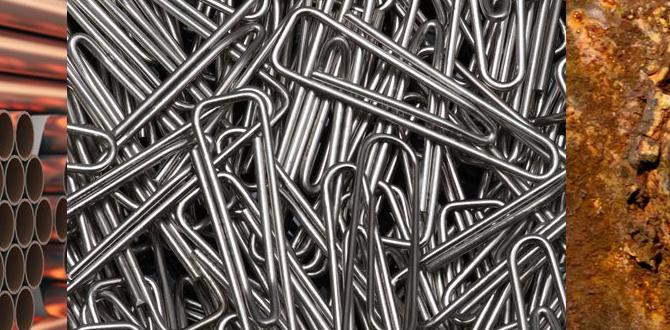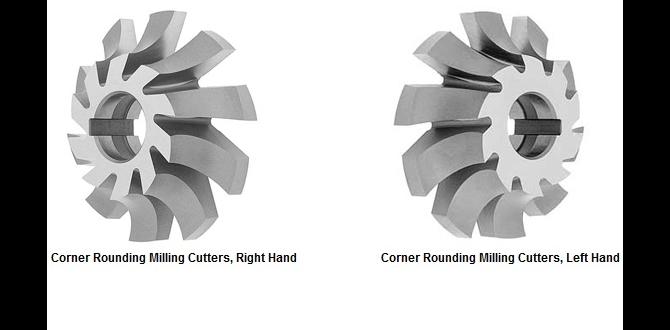Quick Summary
Using a carbide end mill for FR4 dry cutting is essential for clean, precise results without melting. This guide shows beginners how to select and use the right carbide end mill for effective FR4 machining, ensuring smooth cuts and protecting your workpiece.
The frustration is real when working with FR4, a common printed circuit board material. You want clean cuts, but often end up with melted plastic, chipped edges, or a dull tool. It can seem like a mystery, but the solution is quite straightforward and relies on the right tool for a common job: a carbide end mill. This guide will walk you through everything you need to know to successfully dry cut FR4, making your projects look professional and saving you valuable time and frustration. We’ll break down which carbide end mills are best and exactly how to use them.
Why Carbide for FR4 Dry Cutting is Essential
FR4, often called fiberglass, is a tough material. It’s made of epoxy resin reinforced with fiberglass cloth. This combination gives it strength, rigidity, and excellent electrical insulation properties, making it a favorite for PCBs. However, these same properties can make it challenging to cut cleanly, especially with improper tools.
When attempting to cut FR4, especially dry (meaning without coolant), several issues can arise:
- Heat Buildup: Friction from cutting generates heat. Standard high-speed steel (HSS) bits struggle to dissipate this heat, leading to melting of the epoxy resin.
- Material Melting: As the resin melts, it gums up the cutting edges of the tool and can fuse back onto the workpiece, creating a messy, unusable edge. This is the most common problem beginners face.
- Chipping and Delamination: The fiberglass components can be prone to chipping or separating from the resin (delamination) if the cutting forces are too high or the tool is not sharp.
- Premature Tool Wear: HSS tools can dull quickly when faced with the abrasive nature of fiberglass.
This is precisely where a carbide end mill shines. Carbide, or more specifically, tungsten carbide, is an extremely hard and wear-resistant material. Its hardness allows it to cut through FR4 with less friction and heat buildup compared to HSS. When paired with the correct geometry and cutting parameters, a carbide end mill becomes the proven essential for clean, efficient, and repeatable FR4 dry cutting.
Understanding Carbide End Mills for FR4
Not all carbide end mills are created equal, and for FR4, specific features make a big difference.
Types of Carbide Flutes
The flutes are the helical grooves on the end mill that carry away chips. For FR4, flute count and design are critical.
- Number of Flutes:
- 2-Flute: Generally preferred for FR4 dry cutting. Fewer flutes mean larger chip gullets (the space between flutes), which are crucial for efficiently removing the material being cut and reducing heat buildup.
- 4-Flute: Can be used, but might struggle more with chip evacuation in dry cutting. They produce a smoother finish and can handle higher feed rates on softer materials, but for FR4, the primary goal is heat and chip management.
- Flute Type:
- Square End Mills: These have flat ends, ideal for pocketing, profiling, and creating sharp internal corners. Most common for FR4 work.
- Ball Nose End Mills: Have rounded ends, used for creating 3D contours and curved surfaces. Less common for basic FR4 cutting.
Carbide Coatings (Optional but Recommended)
While solid carbide is already hard, certain coatings can further enhance performance, though they add cost. For basic FR4 cutting, an uncoated end mill is often sufficient if used correctly. However, if you’re doing a lot of this work or want to maximize tool life, consider:
- ZrN (Zirconium Nitride): Offers good lubricity and can reduce friction and heat.
- AlTiN (Aluminum Titanium Nitride): Excellent for high-temperature applications, providing good wear resistance.
For FR4 dry cutting, the primary driver of success is the carbide material and proper flute design, rather than advanced coatings.
Shank and Diameter Considerations
When choosing your carbide end mill, consider its physical dimensions:
- Diameter: Common sizes range from 1/16″ up to 1/2″ (or 2mm to 12mm). For PCB prototyping and general FR4 work, 1/8″ (3.175mm) and 3/16″ (4.76mm) are very popular. A smaller diameter allows for finer detail work.
- Shank Diameter: This is the part that goes into your tool holder. It typically matches the cutter diameter (e.g., a 1/8″ cutter often has a 1/8″ shank) but can also be larger for increased rigidity.
- Length of Cut: The fluted portion of the end mill. Ensure it’s long enough for your intended cut depth.
- Overall Length: Affects how far the end mill extends from your spindle.
Specifically for FR4, a common and highly effective choice is a carbide end mill 3/16 inch 8mm shank long reach for FR4 dry cutting. The 3/16 inch diameter is versatile, while an 8mm shank offers good rigidity. “Long reach” can be beneficial for accessing areas without interference.
Selecting the Right Carbide End Mill for Your FR4 Project
To make the best choice, ask yourself these questions:
- What is the desired detail level? For intricate designs or small components, you’ll need a smaller diameter end mill (e.g., 1/16″ or 1/8″).
- What is the depth of cut? Ensure the “length of cut” on the end mill is sufficient.
- What machine are you using? A robust CNC machine can handle slightly more aggressive cutting than a manual mill or a hobbyist rotary tool.
- What is your budget? Standard solid carbide end mills are very effective and reasonably priced for hobbyists.
For general FR4 routing or milling, a 2-flute, solid carbide, square end mill with a diameter of 1/8″ (3.175mm) or 3/16″ (4.76mm) is a fantastic starting point for beginners. If you frequently work with FR4 or require extended reach, look for options like the “carbide end mill 3/16 inch 8mm shank long reach for FR4 dry cutting.”
Step-by-Step Guide to Dry Cutting FR4 with a Carbide End Mill
Proper setup and execution are key to achieving excellent results and ensuring tool longevity. Follow these steps carefully.
Step 1: Safety First!
Machining FR4 generates fine dust that can be harmful if inhaled. Always wear:
- Safety Glasses or a Face Shield: To protect your eyes from flying debris.
- Dust Mask or Respirator: Crucial for FR4 dust. A P100 respirator is recommended.
- Hearing Protection: Milling can be noisy.
- Gloves (Optional): To prevent minor cuts or abrasions, but ensure they don’t get caught in the machinery.
Ensure your work area is well-ventilated. Consider setting up a dust collection system directly at the point of cut if possible; many CNC routers have dust collection ports.
Step 2: Secure Your Workpiece
FR4 must be held firmly to prevent movement during cutting. Any slippage can lead to inaccurate cuts, tool breakage, or workpiece damage.
- Workholding Options:
- Clamps: Use C-clamps or specialized workholding clamps to attach the FR4 to your machine’s table. Ensure clamps do not interfere with the cutting path of the end mill.
- Double-Sided Tape: For very light cuts and small pieces, strong double-sided tape can work, but it’s less secure.
- Vacuum Table: If your machine has one, this is an excellent method for holding FR4 securely without the risk of clamp interference.
- Fixturing: For repeatable operations, consider designing and building a custom fixture to hold your FR4 precisely.
- Support Underneath: For through-cuts, place a sacrificial backing board (like MDF or plywood) underneath your FR4. This prevents the end mill from digging into your machine table and can help prevent tear-out on the bottom edge.
Step 3: Set Up the Carbide End Mill
Ensure the end mill is properly installed in your machine’s spindle or collet.
- Collet/Tool Holder: Use a clean, correctly sized collet or tool holder for your end mill’s shank diameter. A loose fit can lead to runout (wobble) and poor cut quality.
- Engage Depth: Insert the shank of the end mill into the collet/tool holder to the recommended depth for rigidity. Avoid using only the very tip of the collet for long, slender end mills.
- Check for Runout: If your machine has a dial indicator, check the runout of the end mill in the spindle. Minimal runout is crucial for precise cuts.
Step 4: Determine Cutting Parameters (Speeds and Feeds)
This is where many beginners struggle. Incorrect speeds and feeds lead to heat, melting, and tool breakage. For FR4 dry cutting with carbide, you generally want to:
- Spindle Speed (RPM): A moderate to high RPM is usually good for carbide. For a 1/8″ or 3/16″ end mill, start in the range of 18,000-25,000 RPM.
- Feed Rate (IPM or mm/min): This is how fast the tool moves through the material. You need a feed rate that allows the end mill to cut effectively and evacuate chips, but not so fast that it overheats or chatters. Often, a feed rate of 10-30 IPM (250-750 mm/min) is a good starting point.
- Depth of Cut (DOC): Per pass, keep this relatively shallow. For a 1/8″ end mill, a DOC of 0.02″ – 0.05″ (0.5mm – 1.2mm) is often suitable. For a 3/16″ end mill, you might go slightly deeper, 0.03″ – 0.08″ (0.75mm – 2mm).
Important Note on Speeds and Feeds: These are general guidelines. The exact optimal settings depend on your specific machine’s rigidity, the exact FR4 material thickness, the end mill’s geometry, and even ambient temperature. It’s always best to start conservatively and increase parameters gradually while observing the cut.
A helpful resource for recommended cutting parameters for various materials and tools can be found from organizations like the Manufacturing USA, though specific FR4 IPM/RPM for small carbide end mills might require some experimentation.
Here’s a simplified table for starting points:
| End Mill Size | Flutes | Spindle Speed (RPM) | Feed Rate (IPM) | Depth of Cut (DOC – inches) |
|---|---|---|---|---|
| 1/8″ (3.175mm) | 2 | 18,000 – 24,000 | 10 – 20 | 0.02 – 0.04 |
| 3/16″ (4.76mm) | 2 | 16,000 – 22,000 | 15 – 25 | 0.03 – 0.06 |
Tip: The sound of the cut is a good indicator. A smooth, consistent whirring sound is good. A loud, chattering, or grinding noise suggests your feed rate or depth of cut is wrong.
Step 5: Zeroing and Probing
Before cutting, you need to tell your machine where your workpiece surface is.
- Surface Height: Use a touch probe, edge finder, or manual probing method to accurately set your X, Y, and Z zero points on the FR4 material.
- Cut Depth: Precisely set the final Z depth for your cut. Remember to account for the thickness of your FR4 and the desired cut depth per pass.
Step 6: Perform the Cut
With everything set up, it’s time to cut.
- Start Slowly: If using a CNC, run the program through an “air cut” (a few inches above the material) to verify your toolpaths and movement.
- Initiate the Cut: Begin your operation.
- Observe: Watch and listen. If you see excessive smoke, melting, or hear chattering, stop the machine immediately and adjust your feed rate or depth of cut. Increasing the feed rate slightly or decreasing the depth of cut are common first steps for troubleshooting.
- Chip Evacuation: For FR4 dry cutting, chip evacuation is paramount. Ensure chips are being thrown clear. If they are packing into the flutes, you may need to slow down your feed rate or increase your spindle speed slightly, or take shallower passes.
- Cooling (Optional but Recommended): Even with carbide, a little help can go a long way.
- Air Blast: A directed stream of compressed air can help cool the bit and blow chips away.
- Misting Systems: For more demanding work, a very light mist of cutting fluid can significantly reduce debris and heat, though this moves away from “dry cutting.”
- Post-Processing: Once the cut is complete, carefully remove the milled part. You may need to deburr any small imperfections with a deburring tool or fine-grit sandpaper.
Troubleshooting FR4 Dry Cutting Challenges
Even with the best tools, you might encounter issues. Here’s how to address them:
| Problem | Possible Causes | Solutions |
|---|---|---|
| Melting Plastic | Feed rate too slow, spindle speed too high, insufficient chip evacuation. | Increase feed rate slightly, reduce spindle speed, take shallower passes. Ensure flutes are clear. |
| Chipping/Chiseling Edges | Feed rate too fast, depth of cut too aggressive, dull end mill, inadequate workholding. | Reduce feed rate, decrease depth of cut, ensure end mill is sharp. Improve workholding rigidity. |
| Excessive Dust/Smoke | Feed rate too slow, poor chip evacuation, dull end mill. | Increase feed rate, shallow passes. Ensure dust collection is optimized. Replace dull end mill. |
| Tool Breakage | Feed rate too high, depth of cut too aggressive, workholding failure, plunging too fast, worn/damaged tool. | Reduce feed rate and DOC. Secure workpiece properly. Use programmed plunge rates. Inspect tool for damage before use. |
| Poor Surface Finish | Worn end mill, incorrect speeds/feeds, excessive runout. | Use a sharp end mill. Optimize parameters. Check spindle for runout. Ensure a climb mill (vs. conventional mill) is being used if appropriate. |
Benefits of Dry Cutting FR4 with Carbide
Why go through the trouble? The advantages are substantial for hobbyists and professionals alike:
- Clean Cuts: Achieve crisp,






